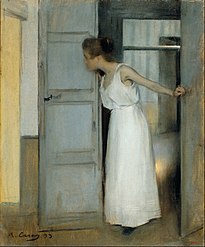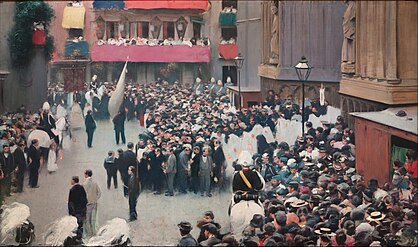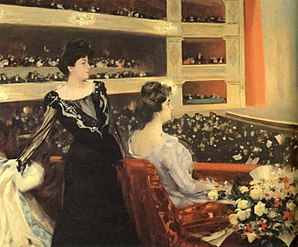A | B | C | D | E | F | G | H | CH | I | J | K | L | M | N | O | P | Q | R | S | T | U | V | W | X | Y | Z | 0 | 1 | 2 | 3 | 4 | 5 | 6 | 7 | 8 | 9
This article needs additional citations for verification. (February 2013) |
Ramon Casas | |
|---|---|
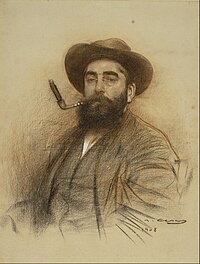 Self-portrait, 1908 | |
| Born | Ramon Casas i Carbó 4 January 1866 Barcelona, Spain |
| Died | 29 February 1932 (aged 66) Barcelona, Spain |
| Known for | Painting |
| Movement | Modernisme |
Ramon Casas i Carbó (Catalan pronunciation: [rəˈmoŋ ˈkazəs]; 4 January 1866 – 29 February 1932) was a Catalan artist. Living through a turbulent time in the history of his native Barcelona, he was known as a portraitist, sketching and painting the intellectual, economic, and political elite of Barcelona, Paris, Madrid, and beyond. He was also known for his paintings of crowd scenes ranging from the audience at a bullfight to the assembly for an execution to rioters in the Barcelona streets (El garrot). Also a graphic designer, his posters and postcards helped to define the Catalan art movement known as modernisme.[1]
Barcelona and Paris

Casas was born in Barcelona. His father had made a fortune in Matanzas, Cuba; his mother was from a well-off Catalan family. In 1877 he abandoned the regular course of schooling to study art in the studio of Joan Vicens. In 1881, still in his teens, he was a co-founder of the magazine L'Avenç; the 9 October 1881 issue included his sketch of the cloister of Sant Benet in Bages. That same month, accompanied by his cousin Miquel Carbó i Carbó, a medical student, he began his first stay in Paris, where he studied that winter at the Carolus Duran Academy and later at the Gervex Academy, and functioned as a Paris correspondent for L'Avenç. The next year he had a piece exhibited in Barcelona at the Sala Parés, and in 1883 in Paris the Salon des Champs Elysées exhibited his portrait of himself dressed as a flamenco dancer; the piece won him an invitation as a member of the salon of the Societé d'artistes françaises.

The next few years he continued to paint and travel, spending most autumns and winters in Paris and the rest of the year in Spain, mostly in Barcelona but also in Madrid and Granada; his 1886 painting of the crowd at the Madrid bullfighting ring was to be the first of many highly detailed paintings of crowds. That year he survived tuberculosis, and convalesced for the winter in Barcelona. Among the artists he met in this period of his life, and who influenced him, were Laureà Barrau, Santiago Rusiñol, Eugène Carrière, Pierre Puvis de Chavannes, and Ignacio Zuloaga.
Casas and Rusiñol traveled through Catalonia in 1889, and collaborated on a short book Por Cataluña (desde mi carro), with text by Rusiñol and illustrations by Casas. Returning together to Paris, they lived together at the Moulin de la Galette in Montmartre, along with painter and art critic Miquel Utrillo and the sketch artist Ramon Canudas. Rusiñol chronicled these times in as series of articles "Desde el Molino" ("From the Mill") for La Vanguardia; again Casas illustrated. Casas became an associate of the Societé d'artistes françaises, allowing him to exhibit two works annually at their salon without having to pass through jury competition.
With Rusiñol and with sculptor Enric Clarasó he exhibited at Sala Parés in 1890; his work from this period, such as Plen Air and the Bal du Moulin de la Galette lies somewhere between an academic style and that of the French impressionists. The style that would become known as modernisme had not yet fully come together, but the key people were beginning to know one another, and successful Catalan artists were increasingly coming to identify themselves with Barcelona as much as with Paris.

His fame continued to spread through Europe and beyond as he exhibited successfully in Madrid (1892, 1894), Berlin (1891, 1896) and at the World Columbian Exposition in Chicago (1893); meanwhile the bohemian circle that included Casas and Rusiñol began with greater frequency to organize exhibitions of their own in Barcelona and Sitges. With this increasing activity in Catalonia, he settled more in Barcelona, but continued to travel to Paris for the annual Salons.
Els Quatre Gats

The emerging modernista art world gained a center with the opening of Els Quatre Gats, a bar modeled on Le Chat Noir in Paris. Casas largely financed this bar on the ground floor of Casa Martí, a building by Architect Josep Puig i Cadafalch in Montsió Street near the center of Barcelona; it opened in June 1897 and lasted for six years (and was later reconstructed in 1978). His partners in the enterprise were Pere Romeu, who largely played host to the bar, as well as Rusiñol and Miquel Utrillo.

The bar hosted tertulias and revolving art exhibits, including one of the first one-man shows by Pablo Picasso; the most prominent piece in its permanent collection was a lighthearted Casas self-portrait, depicting him smoking a pipe while pedaling a tandem bicycle with Romeu as his stoker. The original of the painting—or most of it: nearly a third of the canvas was cut away by an intervening owner—is now in Barcelona's Museu Nacional d'Art de Catalunya (MNAC); a creditable reproduction resides in the revived Els Quatre Gats.
Like Le Chat Noir, Els Quatre Gats attempted its own literary and artistic magazine, to which Casas was a major contributor. That was short-lived, but was soon followed by Pèl & Ploma, which would slightly outlast the bar itself, and Forma (1904–1908), to which Casas also contributed. Pèl & Ploma sponsored several prominent art exhibitions, including Casas' own well-received first solo show (1899 at Sala Parés), which brought together a retrospective of his oil paintings as well as a set of charcoal sketches of contemporary figures prominent in Barcelona's cultural life.
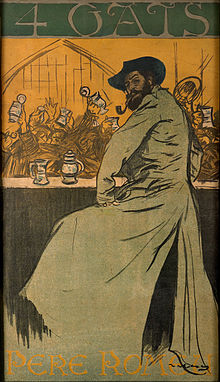
While his painting career continued successfully through this period, as part owner of a bar Casas engaged heavily in graphic design, adopting the art nouveau style that would come to define modernisme. He designed posters for the café, many of which depicted Romeu's gaunt visage. He also executed a series of advertisements for Codorniu, a brand of cava (or, as its ads of the time claimed, champagne) and anisette. Over the next decade, he would design poster ads for everything from cigarette papers to the Enciclopèdia Espasa.
His prominence grows
For the 1900 Exposition Universelle (1900) in Paris, the Spanish committee chose two of Casas' full-length oil portraits: an 1891 portrait of Erik Satie[2] and an 1895 portrait of Casas' sister Elisa. His 1894 Garrote Vil —a portrayal of an execution— won a major prize in Munich in 1901; his work was shown not only in the major capitals of Europe, but as far away as Buenos Aires, Argentina. In 1902, twelve of his canvasses were installed permanently in the rotunda of the Cercle de Liceu, the exclusive private club associated with Barcelona's famous opera house.

In 1903 he became a full Societaire of the Salon du Champ de Mars in Paris, which would have allowed him to exhibit there annually, but in fact he only exhibited there for two more years. In 1903, his piece for the salon was one that had originally been called La Carga (The Charge), which he retitled Barcelona 1902 in reference to a recent general strike, although in fact the painting, which shows Guardia Civil routing a crowd, had been executed at least two years before that strike. In 1904, the same piece won first prize at the General Exposition in Madrid.

During a 1904 sojourn in Madrid, he produced a series of sketches of the Madrid intelligentsia, and befriended painters Eliseu Meifrèn and Joaquín Sorolla, as well as Agustí Querol Subirats, official sculptor to the Spanish government. In Querol's studio, he executed an equestrian portrait of the king, Alfonso XIII, which was soon purchased by the American collector Charles Deering, who, over the next few years would commission or purchase several of Casas paintings.
Júlia Peraire

Increasingly in demand as a portraitist, he settled again for a while in Barcelona. Shortly thereafter he made the acquaintance of a young artist's model named Júlia Peraire, 22 years his junior. He first painted her in 1906 when she was 18. She soon became his favorite model and his lover. His family did not approve of her; they eventually married, but not until 1922.
Patronage and stardom
Casas' mother purchased the monastery of Sant Benet de Bages in 1907 and hired Puig i Cadafalch to restore it. Casas would spend much time there, and would repeatedly depict the monastery and its surroundings. Five years later, when his mother died, he inherited the monastery.

In 1908 Casas and his now-patron Deering traveled through Catalonia. Deering purchased a former hospital in Sitges to transform it into a sometime residence. Miquel Utrillo dubbed it Marycel. Later that year, Casas began a six-month journey to Cuba and the United States at Deering's invitation. During this time, he executed a dozen oil portraits and over thirty charcoal drawings of Deering's friends and associates.
Returning to Spain in April 1909, he put on solo shows in both Barcelona and Madrid. At the Fayanç Català gallery in Barcelona, he displayed 200 charcoal sketches, which he then donated to the Museo de Barcelona. His show in Madrid was at the Ministry of Tourism, and featured portraits of the city's leading figures, including the king.
His life continued in this vein for some time. In 1910 executed a painting of the funeral of his friend the art critic and novelist Raimon Casellas, who had committed suicide the previous year shortly after Barcelona's semana trágica and, for Deering, painted a second version of La Carga, this time with the prominent foreground figure of a Guardia Civil on foot rather than on horseback. Over the remaining years before World War I he traveled extensively in Spain and Europe, sometimes alone and sometimes with Deering, visiting Vienna, Budapest, Munich, Paris, the Netherlands, Madrid, and Galicia. He continued to have major exhibits in Spain and France. In 1913 he acquired an architecturally notable home in Barcelona, a tower on Carrer de San Gervasi (now Carrer de les Carolines) in the Sant Gervasi neighborhood; in 1915, he, Rusiñol, and Clarassó exhibited together in the Sala Parés, celebrating the 25th anniversary of their first joint exhibition there.
Tamarit and after
In 1916, Casas and Deering traveled to Tamarit in Catalonia. Deering purchased the entire village, and placed Casas in charge of the project of restoring it. Several years later, in 1924, he would return to Tamarit to paint numerous landscapes.
Also in 1916, Deering purchased a house in Sitges, known as Can Xicarrons (now a museum), and the magazine Vell i Nou dedicated an issue to Casas.
Up until this time, Casas had kept his distance from the battles of World War I, but in 1918 he visited the front; he painted a self-portrait wearing a military cape.
Casas, Rusiñol, and Clarasó resumed regular annual joint exhibitions at Sala Parés in 1921; these continued until Rusiñol's death in 1931. However, that year he had a falling out with his friend Utrillo over Maricel Casas's close association with Deering; the breach was never healed.
In 1922, Casas finally married Júlia Peraire, and in 1924 she came along with him on a trip to the United States, during which he once again made portraits of the rich and famous.

By the 1920s, Casas had fallen far away from the avant-gardiste tendencies of his youth. If anything, his work from this period looks like of an academic painter of an earlier time than his work of the 1890s. He continued to paint landscapes and portraits, as well as anti-tuberculosis posters and others, but by the time of his death in 1932, shortly after the emergence of the Second Spanish Republic, he was already more a figure of the past.
Selected works
-
Portrait of Montserrat Carbó, 1888
-
Plein air, c. 1890–91
-
Open Air Interior, 1892 (Ramon's sister Montserrat and his brother-in-law Eduardo Nieto)
-
Au Moulin de la Galette, 1892
-
Over My Dead Body, 1893
-
Female Nude, 1894
-
Leafless Flowers (es), 1894
-
Courtyard of the old Barcelona prison (Courtyard of the 'lambs'), c. 1894
-
At the ball, 1896
-
Decadente, 1899
-
Cover of Hispania magazine no. 4
-
Design for the poster 'Sífilis', 1900, charcoal and pastel on paper
-
Celebrations in Toulon, 1900
-
Female Figure in Red, c. 1900
-
Ballerinas, 1901–02
-
Opera, 1901–02
-
Cafe Concert, c. 1901–02
-
Anteroom of the box, c. 1901–02
-
Alfonso XIII, King of Spain, 1904
-
Mademoiselle Clo Clo, pastel
References
- ^ HydraMedia (2016-03-12). "Year Ramon Casas". Museus de Sitges. Retrieved 2018-01-02.
- ^ Avril in Paris at www.artnet.com
- Curiosities about Ramon Casas Archived 2012-04-25 at the Wayback Machine
External links
>Text je dostupný pod licencí Creative Commons Uveďte autora – Zachovejte licenci, případně za dalších podmínek. Podrobnosti naleznete na stránce Podmínky užití.
Wikipedia:Verifiability
Special:EditPage/Ramon Casas
Help:Referencing for beginners
Help:Maintenance template removal
Catalan name
Surname
File:Ramon Casas - Self-portrait - Google Art Project (559678).jpg
Barcelona
Painting
Modernisme
Help:IPA/Catalan
Barcelona
Paris
Madrid
Modernisme
File:Ramon Casas Flamenco.jpeg
Flamenco
Matanzas
Cuba
Bages
Paris
Sala Parés
Flamenco
File:Ramon Casas- MNAC- Toros (Cavalls morts) o A l'estiu, tota cuca viu.jpg
Madrid
Granada
Tuberculosis
Laureano Barrau
Santiago Rusiñol
Eugène Carrière
Pierre Puvis de Chavannes
Ignacio Zuloaga
Montmartre
Miquel Utrillo
Enric Clarasó
Impressionism
File:Garrote vil, de Ramón Casas.jpg
Garrote vil
Berlin
World Columbian Exposition
Chicago
Bohemianism
Sitges
File:Cartell putxinellis quatre gats-MAE-25221.jpeg
Els Quatre Gats
Els Quatre Gats
Le Chat Noir
Casa Martí
Josep Puig i Cadafalch
File:15-10-27-Els Quatre Gats-RalfR-WMA 2740a.jpg
Ramon Casas and Pere Romeu on a Tandem
Tertulia
Pablo Picasso
Tandem bicycle
Museu Nacional d'Art de Catalunya
Pèl & Ploma
File:Ramon Casas - 4 Gats - Google Art Project.jpg
Art nouveau
Codorniu
Catalan wine#Cava
Champagne (wine)
Anisette
Rolling paper
Enciclopedia universal ilustrada europeo-americana
Exposition Universelle (1900)
Erik Satie
File:Garrote vil, de Ramón Casas.jpg
Buenos Aires
Argentina
File:Ramon Casas Charge.jpg
General strike
Guardia Civil
File:Hispano Suiza 1905.jpg
Teresa Mariani
Eliseu Meifrèn
Joaquín Sorolla
Agustí Querol Subirats
Alfonso XIII of Spain
United States
Charles Deering
File:Ramon Casas Carbó Julia.jpg
Bages
File:Ramon Casas Deering Portrait.jpg
Charles Deering
Sitges
Raimon Casellas
Spain under the Restoration#The Crisis of the System .281898 - 1923.29
World War I
Vienna
Budapest
Munich
Netherlands
Madrid
Galicia (Spain)
Sitges
Vell i Nou
World War I
File:Ramon Casas 1929 Tubercolosis poster.jpg
Avant garde
Second Spanish Republic
File:(Barcelona) Retrat de Montserrat Carbo - 1888 - Ramon Casas - Museu Nacional d'Art de Catalunya.jpg
File:Ramon Casas - Plein air - Google Art Project.jpg
File:Interior a l'aire lliure.jpg
File:Au Moulin de la Galette.jpg
File:Ramon Casas - Over My Dead Body - Google Art Project.jpg
Over My Dead Body (Ramon Casas)
File:Ramon Casas i Carbó - Nu femení (Cau Ferrat Museum).tiff
File:Flores deshojadas (Ramón Casas).jpg
Flores deshojadas
File:Ramon Casas - Courtyard of the old Barcelona prison (Courtyard of the 'lambs') - Google Art Project.jpg
File:Ball de tarda.jpg
File:Ramon Casas - The Corpus Christi Procession Leaving the Church of Santa Maria del Mar - Google Art Project.jpg
The Corpus Christi Procession Leaving the Church of Santa Maria del Mar
File:4 Decadente 18991.jpg
File:Portada de Hispania (revista) nº4.jpg
File:Ramon Casas - Original design for the poster 'Sífilis' - Google Art Project.jpg
File:Ramon Casas - Celebrations in Toulon - Google Art Project.jpg
File:Ramon Casas - Female Figure in Red - Google Art Project.jpg
File:Ramon Casas - Ramon Casas and Pere Romeu in an Automobile - Google Art Project.jpg
Ramon Casas and Pere Romeu in an Automobile
File:Casas-CL-CosBall.jpg
File:Casas-CL-Liceu.jpg
File:Casas-CL-CafeConcert.jpg
File:Casas-CL-Avantsala.jpg
File:Alfonso XIII, Rey de España - Ramón Casas y Carbó.jpg
File:Mademoiselle Clo-Clo.jpg
Wayback Machine
Category:Ramon Casas
Template:Ramon Casas
Template talk:Ramon Casas
Special:EditPage/Template:Ramon Casas
Bal du Moulin de la Galette (Casas)
Over My Dead Body (Casas)
Garrote vil (Garrotte)
Ramon Casas and Pere Romeu on a Tandem
The Corpus Christi Procession Leaving the Church of Santa Maria del Mar
Ramon Casas and Pere Romeu in an Automobile
Modernisme
Q725681#identifiers|class=noprint|Edit this at Wikidata
Q725681#identifiers|class=noprint|Edit this at Wikidata
Help:Authority control
Q725681#identifiers
Ramon Casas
Ramon Casas
Main Page
Wikipedia:Contents
Portal:Current events
Special:Random
Wikipedia:About
Wikipedia:Contact us
Special:FundraiserRedirector?utm source=donate&utm medium=sidebar&utm campaign=C13 en.wikipedia.org&uselang=en
Help:Contents
Help:Introduction
Wikipedia:Community portal
Special:RecentChanges
Wikipedia:File upload wizard
Main Page
Special:Search
Help:Introduction
Special:MyContributions
Special:MyTalk
Рамон Касас
Ramon Casas i Carbó
Ramon Casas i Carbó
Ramon Casas i Carbó
Ραμόν Κάζας
Ramón Casas
Ramón Casas
Ramon Casas
رامون کازاس
Ramon Casas
Ռամոն Կասաս
Ramon Casas
רמון קאזס
رامون كاساس
Ramon Casas i Carbó
ラモン・カザス
Ramon Casas
Касас, Рамон
Ramon Casas i Carbó
Ramon Casas
Ramon Casas
Рамон Касас
Special:EntityPage/Q725681#sitelinks-wikipedia
Ramon Casas
Talk:Ramon Casas
Ramon Casas
Ramon Casas
Special:WhatLinksHere/Ramon Casas
Special:RecentChangesLinked/Ramon Casas
Wikipedia:File Upload Wizard
Special:SpecialPages
Special:EntityPage/Q725681
Category:Ramon Casas
Ramon Casas
Ramon Casas
Main Page
Wikipedia:Contents
Portal:Current events
Special:Random
Wikipedia:About
Wikipedia:Contact us
Special:FundraiserRedirector?utm source=donate&utm medium=sidebar&utm campaign=C13 en.wikipedia.org&uselang=en
Help:Contents
Help:Introduction
Wikipedia:Community portal
Special:RecentChanges
Wikipedia:File upload wizard
Main Page
Special:Search
Help:Introduction
Special:MyContributions
Special:MyTalk
Рамон Касас
Ramon Casas i Carbó
Ramon Casas i Carbó
Ramon Casas i Carbó
Ραμόν Κάζας
Ramón Casas
Ramón Casas
Ramon Casas
رامون کازاس
Ramon Casas
Ռամոն Կասաս
Ramon Casas
רמון קאזס
رامون كاساس
Ramon Casas i Carbó
ラモン・カザス
Ramon Casas
Касас, Рамон
Ramon Casas i Carbó
Ramon Casas
Ramon Casas
Рамон Касас
Special:EntityPage/Q725681#sitelinks-wikipedia
Ramon Casas
Talk:Ramon Casas
Ramon Casas
Ramon Casas
Special:WhatLinksHere/Ramon Casas
Special:RecentChangesLinked/Ramon Casas
Wikipedia:File Upload Wizard
Special:SpecialPages
Special:EntityPage/Q725681
Category:Ramon Casas
Ramon Casas
Ramon Casas
Main Page
Wikipedia:Contents
Portal:Current events
Special:Random
Wikipedia:About
Wikipedia:Contact us
Special:FundraiserRedirector?utm source=donate&utm medium=sidebar&utm campaign=C13 en.wikipedia.org&uselang=en
Help:Contents
Help:Introduction
Wikipedia:Community portal
Special:RecentChanges
Wikipedia:File upload wizard
Main Page
Special:Search
Help:Introduction
Special:MyContributions
Special:MyTalk
Рамон Касас
Ramon Casas i Carbó
Ramon Casas i Carbó
Ramon Casas i Carbó
Ραμόν Κάζας
Ramón Casas
Ramón Casas
Ramon Casas
رامون کازاس
Ramon Casas
Ռամոն Կասաս
Ramon Casas
רמון קאזס
رامون كاساس
Ramon Casas i Carbó
ラモン・カザス
Ramon Casas
Касас, Рамон
Ramon Casas i Carbó
Ramon Casas
Ramon Casas
Рамон Касас
Special:EntityPage/Q725681#sitelinks-wikipedia
Ramon Casas
Talk:Ramon Casas
Ramon Casas
Ramon Casas
Special:WhatLinksHere/Ramon Casas
Special:RecentChangesLinked/Ramon Casas
Wikipedia:File Upload Wizard
Special:SpecialPages
Special:EntityPage/Q725681
Category:Ramon Casas
Updating...x
Text je dostupný za podmienok Creative
Commons Attribution/Share-Alike License 3.0 Unported; prípadne za ďalších
podmienok.
Podrobnejšie informácie nájdete na stránke Podmienky
použitia.




